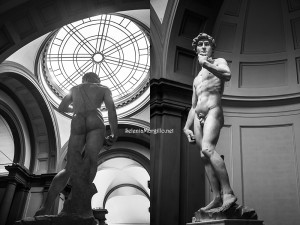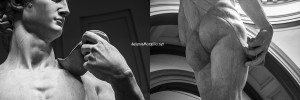Michelangelo’s David: the greatest of the Renaissance statuary
(Italian Version below*)
In 1464 the workers of the Opera del Duomo commissioned to Agostino di Duccio a marble colossus almost six meters high to be placed on one of the buttresses of the Duomo in Florence (Santa Maria del Fiore).
The idea of a colossal statue (Colossus of Nero in Rome, Colossus of Rhodes) dated back to antiquity and it was difficult to replicate them, if not impossible.
After a short time Agostino di Duccio left the job, the superintendents of the Opera did not give up and just in 1476 they entrusted another artist, Antonio Rossellino, with the task of completing a “marble giant”.
Even for Rossellino’s work, there was no follow-up!
In the early months of 1501 when the Workers put that “giant” back on its feet and began the search for an artist who knew how to bring that figure to dignity to completion.
It was possible to choose only one name “on the square”, the best: he was Michelangelo Buonarroti, he was 26 years old at that time, but he had already amazed everyone with the Vatican Pietà made some years before.
Michelangelo began the David in September 1501 and showed it to the Florentines three years later, in 1504. He worked continuously during this period of day and night, making himself light with a headdress of candles.
The Opera del Duomo had established the religious subject, but could not imagine such a surprising and countercurrent outcome.
The David of the Bible was a young man who, with the mere force of faith, kills Goliath with a slingshot; Michelangelo’s sculpture with shining and polished marble with its 410 cm shows his strength and his courage in the awareness of a beautiful although not perfect body, far and at the same time close to the classical canons.
The iconography is not the classic one: David is sculpted – “caught” in the moment preceding the action, or in that instant of maximum tension before the killing of Goliath which unlike other interpretations (Ghiberti, Donatello) does not appear right in the eyes of the observer.
Hands and head are slightly disproportionate as a whole, as Michelangelo had thought of a different location (Duomo buttresses).
This is the first theory, a second idea wants the artist consciously focused on impressing the concepts of intelligence (Head) and power (Hand) in marble.
The statue was to praise the sense of independence and freedom that animated the Florentine Republic in those years.
A commission was established to decide where to place the statue.
Leonardo, who did not love Michelangelo, proposed to place it under the Loggia in Piazza Della Signoria so that it was “sheltered” and away from the eyes, Botticelli who had a kinder and already decaying spirit proposed an area close to the Duomo, Filippino Lippi’s idea of placing it next to the door of Palazzo Vecchio in Piazza Della Signoria where a copy can still be admired, a positioning that later coincided with the ideas of Michelangelo who wished for a central position for the sculpture to dialogue with the city and its new ideas of freedom.
“The marble giant was pulled out of the Opera at 24 hours and broke the wall above the door so that it could come out“
At the end of the 19th century to protect it from the elements, it was transferred to the Accademia Gallery in a specially built tribune from De Fabris.
Giorgio Vasari defined the David, a masterpiece of Renaissance statuary, a work that had “removed” the cry from all modern and ancient statues, Greek or Latin, whoever saw the David saw it all.
Beauty consists not only in perfect anatomy but in the extraordinary tenderness that Michelangelo has been able to give to his nude.
To find out more and where to find it: HERE
——————————————————————————————————————–
Nel 1464 gli operai dell’Opera del Duomo commissionarono ad Agostino di Duccio un colosso marmoreo alto quasi sei metri da collocare su uno dei contrafforti del Duomo di Firenze. Le statue colossali risalivano all’antichità ed era difficile replicarle, se non impossibile.
Dopo poco Agostino di Duccio abbandonò il lavoro, i sovrintendenti dell’Opera non si diedero per vinti e nel 1476 affidarono ad Antonio Rossellino l’incarico di portare a termine un “gigante di marmo”.
Anche per il lavoro del Rossellino non ci fu seguito!
Si arrivò ai primi mesi del 1501 quando gli Operai rimisero in piedi quel “gigante” ed iniziarono la ricerca di un artista che sapesse portare quella figura dignitosamente a compimento.
Il nome prescelto fu quello di Michelangelo che a 26 anni aveva già stupito tutti con la Pietà Vaticana.
Michelangelo iniziò il lavoro del David, nel settembre del 1501 e lo mostrò ai fiorentini tre anni più tardi, nel 1504, lavorando ininterrottamente in questo periodo di giorno e di notte facendosi luce con un copricapo di candele.
L’Opera del Duomo aveva stabilito il soggetto religioso, ma non poteva immaginare un esito così sorprendente e controcorrente.
Il David della Bibbia era un giovane che con la sola forza della fede uccide con una fionda Golia; la scultura di Michelangelo dal marmo splendente e levigato con i suoi 410 cm mostra la sua forza ed il suo coraggio nella consapevolezza di un corpo bellissimo anche se non perfetto, lontano e contemporaneamente vicino ai canoni classici.
L’iconografia non è quella classica: David è scolpito – “colto” nel momento che precede l’azione, ovvero in quell’istante di massima tensione prima dell’uccisione di Golia che a differenza di altre interpretazioni (Ghiberti, Donatello) non appare proprio agli occhi dell’osservatore.
Mani e testa risultano leggermente sproporzionate nell’insieme, in quanto Michelangelo aveva pensato ad una collocazione diversa (Contrafforti del Duomo).
Questa è una prima teoria, una seconda idea vuole l’artista coscientemente focalizzato ad imprirere nel marmo i concetti di intelligenza (Testa) e di potenza (Mano).
La statua doveva inneggiare a quel senso di indipendenza e di libertà che animò la Repubblica fiorentina in quegli anni.
Fu istituita una commissione per decidere dove posizionare la statua e Leonardo che non amava Michelangelo propose di collocarla al di sotto della Loggia in Piazza della Signoria così che fosse “riparata” e lontana dagli sguardi; Botticelli che aveva un animo più gentile e già in decadenza propose una zona vicina al Duomo.
Vinse l’idea di Filippino Lippi di collocarla accanto al portone di Palazzo Vecchio in Piazza della Signoria dove tutt’ora si può ammirare una copia, posizionamento che coincideva poi con le idee di Michelangelo il quale auspicava ad una posizione centrale affinchè la scultura dialogasse con la città e con i suoi nuovi ideali di libertà.
“Si trasse dall’Opera il gigante di Marmo usci fuori alle 24 ore e ruppero il muro sopra la porta tanto che ne potesse uscire”
A fine ’800 per proteggerla dagli agenti atmosferici, fu trasferita alla Galleria dell’Accademia in una tribuna appositamente costruita dal De Fabris.
Giorgio Vasari definì il David, capolavoro della statuaria rinascimentale, un’opera che aveva “tolto” il grido a tutte le statue moderne e antiche, greche o latine, chi ha visto il David ha visto tutto.
La bellezza consiste non solo nella perfetta anatomia, ma nella straordinaria tenerezza che Michelangelo ha saputo dare al suo nudo.
Per saperne di più e su dove trovarlo: QUI
Sostieni #laculturachevince, aiuta la condivisione.

